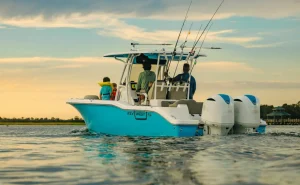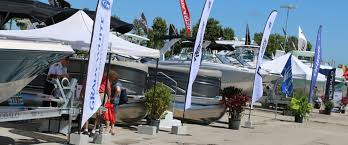
Uniflite Boats
Uniflite emerged as a noteworthy player in the boating industry after its inception in Bellingham, Washington, by Art Nordtvedt in 1957. The company distinguished itself by pioneering in the use of fiberglass for boat construction, offering durability and a modern approach to boat building. Over the years, Uniflite expanded its lineup to include various models ranging from small outboard boats to larger yacht-style cruisers, catering to a wide spectrum of boaters.
The brand’s boats were known for their robust construction and seaworthiness, making them a favored choice for both recreational boaters and government agencies, including the US Navy. However, after a successful run, Uniflite faced challenges and eventually became part of the Chris Craft family in 1985. Today, Uniflite boats continue to be sought after in the pre-owned market, where they are compared against boats of similar size and capabilities.
Key Takeaways
- Uniflite quickly became recognized for their innovative use of fiberglass in boat building.
- The company produced a variety of models that catered to a broad boating audience.
- Despite challenges, the Uniflite legacy continues in the pre-owned market where they remain valued for their durability and design.
History of Uniflite
Uniflite’s legacy as a significant boat manufacturer is marked by its military contributions and eventual evolution under different ownership. This section delves into the crucial milestones in the company's development and its lasting impact on the boating industry.
Founding and Growth
Uniflite was established in October 1957 by Art Nordtvedt in Bellingham, WA, originally operating under the name United Boat Builders. Uniflite started by constructing a 17-foot outboard made entirely of fiberglass—a notable innovation at the time. Over time, the company expanded its lineup to include a variety of outboard and inboard/outboard boats, ranging from 14 to 34 feet in length.
Military Influence and Navy Contracts
During the Vietnam War era, Uniflite’s expertise was recognized on a national level through their navy contracts. They manufactured river patrol boats and later, their use of fire-retardant resins became critical, especially in crafting landing craft used by the military. This aspect of production significantly shaped the company's direction and reputation.
Acquisition by Chris-Craft
In 1984, Uniflite faced financial challenges due to a downturn in the boating market. Consequently, it was acquired by Chris-Craft, a renowned boat manufacturer. Notably, in 1986 several Uniflite models were rebranded and sold under the Chris Craft label and made their way onto the New York Stock Exchange.
Transition to Norstar Boats
After the fire that led to the halt in Uniflite production under the Chris-Craft name, the company re-emerged as Norstar Boats in 1988. They continued crafting high-quality boats, leveraging Uniflite's original boat molds and design philosophy, albeit under new leadership and vision.
Notable Events
A significant event in Uniflite's history was the discovery that some of their boats manufactured in the 1970s were affected by an osmotic process known as "Uniflite blisters," caused by the reaction of fire-retardant resins in the hulls. Furthermore, the engines, particularly the Detroit 6V53's, became distinguished features in several Uniflite models, emphasizing a mix of power and reliability.
Boat Models and Specifications
Uniflite boats are renowned for their robust construction and diverse model lineup, catering to a variety of maritime interests. These vessels often exhibit a blend of form and function, emphasizing both performance and comfort.
Popular Uniflite Models
Uniflite has produced several models that stand out for their popularity and design. The Uniflite 28 Mega is one such craft, known for its durability and classic design. Then there's the Uniflite 26 Whale Boat, which has gained a reputation for utility and adaptability. The 36 Double Cabin is another sought-after model, offering more space and comfort for longer voyages with its spacious aft cabin.
Hull Types and Design Features
Uniflite boats often utilize fiberglass in their construction, providing durability and resistance to water damage. Hull designs vary, with options such as the deep vee for excellent handling in rough waters, and the semi-displacement for a good balance between speed and fuel economy. A key characteristic of Uniflite vessels is their medium-depth draft and wide beam, enhancing stability and interior space.
Size and Capacity
The models range in size, with the 28 Mega providing enough room for day trips and light fishing activities. On the larger end, the 36 Double Cabin offers increased capacity and living space, making it ideal for extended stays aboard. These boats typically cater to individual hobbyists and families alike, with berthing for several passengers depending on the model.
Engine Types
Engine configurations for Uniflite boats vary according to the model and intended use. The options range from gas and diesel engines to outboard, inboard/outboard, and inboard systems. A notable powerplant for some models is the Detroit 6v53 engine, recognized for its reliability and performance in marine applications. Power options are matched to the vessel design, ensuring efficient propulsion and handling characteristics.
Price and Valuation
Understanding the cost of Uniflite boats involves examining the price of new models, the pre-owned market, and factors that influence their valuation.
New Vessels
New Uniflite vessels are a significant investment, embodying quality and durability. Prices can vary widely based on the model, size, and additional features. For example, a standard new Uniflite yacht might start from a base price of hundreds of thousands of dollars. Prospective buyers can view various new Uniflite models on YachtWorld, where the listings offer detailed pricing information.
Pre-owned Market
The pre-owned Uniflite market presents a more affordable entry point than purchasing new. Pre-owned Uniflite boats can range from $10,999 to upwards of $375,000, with the price contingent upon the boat's age, condition, and specifications. Sites like Boat Trader often display a diversity of used Uniflite boats for sale, offering a transparent view on current market valuations.
Factors Affecting Price
Several factors impact the price of Uniflite boats, including engine power, which can range from 25 horsepower in more modest models to 850 horsepower in high-performance ones. The vessel's condition, history of maintenance, any refurbishments, and market demand also play a role in shaping the valuation. The brand's storied history with the U.S. Navy and its reputation for producing rugged and reliable boats further influence buying decisions and, by extension, price points.
Comparable Boats
When evaluating Uniflite boats, understanding their standing in the maritime industry is paramount. The following comparisons will look into Uniflite's standing against various boat categories, brands, and market alternatives, specially considering their position in commercial and
Distribution and Dealerships
Uniflite boats have a well-established network for distribution and sales across the United States and internationally. This network is supported by dealers and yacht brokers who provide a range of Uniflite yachts for sale, boasting a variety of models and pricing options to suit diverse boating needs.
Domestic Dealers
In the United States, Uniflite boats are offered through a selection of reputable dealers and yacht brokers. These sales points cater to boating enthusiasts by showcasing a wide range of Uniflite models. From the versatile and affordable 28-foot Mega to the more luxurious and powerful 42-foot variants, customers can find a vessel that fits their specifications and price range.
- Locations: Spread across key boating states, including Florida, Washington, and California.
- Services: Dealers provide viewing, test sailing, customization services, and after-sales support.
International Presence
Outside of the United States, Uniflite maintains an international presence with partnerships in countries such as Canada. These international dealers are essential for showcasing the Uniflite brand across global waters, making it convenient for overseas customers to access these boats. They too carry a variety of models and support customers through the purchase process.
- Countries: Canada and select others
- Availability: Ranges from smaller outboard boats to longer inboard cruisers
Buying from Brokers
Yacht brokers are integral in the buying and selling process of Uniflite boats. Potential buyers can access a broad selection of new and used Uniflite yachts through platforms like YachtWorld and Boat Trader. Brokers can offer expert advice, assist with negotiations, and manage the documentation required for a yacht sale.
- Role: Brokerage services are pivotal for facilitating the sales, especially for pre-owned models.
- Expertise: They provide market insights, value appraisal, and can guide buyers through various financial options.
Frequently Asked Questions
This section answers common inquiries about Uniflite boats, touching on specifications, pricing history, model popularity, comparable brands, and industry innovations.
What are the specifications of classic Uniflite boat models?
Classic Uniflite boat models like the early fiberglass 17' outboard have varied specs, extending to options such as 14', 18', and 20' sizes, reflecting their commitment to versatility and quality.
How has the pricing of Uniflite boats changed over the years?
Initially, Uniflite boats were known for affordability, but over time, prices have naturally adjusted due to inflation, market demand, and advancements in marine technology, offering a range reflecting both modest and high-end models.
Can you detail the historical development of Uniflite boats?
Uniflite was established by Art Nordtvedt in 1957, and its history is rich with naval craftsmanship that transitions from building Navy Mine Sweepers to pioneering fire retardant resins in pleasure boats.
What are some of the most popular models of Uniflite boats and their features?
The Uniflite lineup includes popular models like the 46 Pacemaker motoryacht, which saw transition to Chris Craft models in the mid-80s, each boasting robust design and luxury features suitable for marine enthusiasts.
Which comparable boat brands compete with Uniflite in terms of quality and price?
Comparable brands like Chris Craft and Pacemaker offer alternatives that resonate with Uniflite's market for those looking for quality and competitive pricing, reflecting a shared commitment to marine craftsmanship and value.
What innovations did Uniflite introduce to the boating industry?
Uniflite was particularly noted for being the only boat builder to use fire-retardant resins in the construction of its pleasure boats, a clear testament to its dedication to safety and innovation within the boating industry.
















